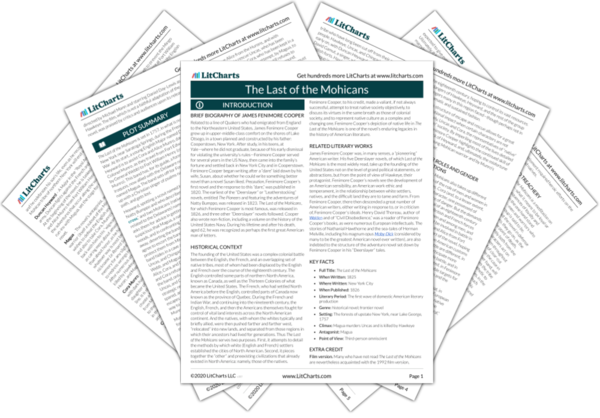Summary
Analysis
Heyward approaches Hawkeye, and says that his party has become lost in the woods—that their guide, the runner, has lost his way. Hawkeye wonders how this is possible, and Heyward explains that the runner was born a Huron (one of the “Mingo” tribes), but has lately fallen in with the Mohawks, allied to the English. Hawkeye wonders aloud whether a Mingo can ever “change his colors,” but Heyward states that they are looking for safe passage to Fort William Henry, and asks whether Hawkeye knows the way to that fort, or back to Fort Edward, where they started.
Another of the novel’s “refrains” is the idea that different characters or tribes can have numerous different names, some given, some descriptive. The Mingos are also called the Maquas or the Iroquois. Hawkeye is also called “Natty Bumppo,” and, in later novels, “The Deerslayer.” These compounded names represent the many linguistic influences in this part of North America.
Themes
Hawkeye asks to see the runner, who is standing back behind the psalmodist (named David) and Alice and Cora; Hawkeye, after looking the runner over, returns to Heyward and says to him, in confidence, that a “Mingo is a Mingo,” and that the runner cannot be trusted. Heyward admits to Hawkeye, also out of earshot of the rest of the party, that he was worried the runner might have been leading them intentionally astray.
Hawkeye and Heyward discuss another idea, which states that the differences between the English and the French, and between different native tribes, derive from innate differences between the characteristics in these groups. In other words, the dislike between Hurons and Delawares is “natural,” a result of deep-seated cultural tendencies.
Themes
Hawkeye tells Heyward to busy the runner, whose name is Magua, or Le Renard Subtil, in conversation, so that he (Hawkeye), Chingachgook, and Uncas can devise a plan either to capture him or scare him off. Hawkeye talks to Magua, saying that Magua must have gotten lost; when Magua hears that Hawkeye might consent to lead the group to Fort William Henry, Magua says that he will leave them, and go off into the woods himself until he reaches that fort.
Magua’s treachery throughout the novel is discussed by nearly all the book’s major characters. Magua has managed, as a Huron, to live among the Delawares and the English for some time, without causing the Hurons to distrust him, or at least not very much—as evidenced later on. Magua is perhaps the novel’s most intelligent, most convincing and persuasive character.
Themes
Heyward, however, asks Magua whether that is a wise move—leaving the party—since Magua has been promised a reward by Munro, commander of Fort William Henry and father to Alice and Cora, if the whole party is delivered safely to the fort. Heyward tells Magua to sit and eat while the group rests for the night, and prepares to travel in a body for the fort the next day. Grudgingly, Magua mumbles to himself that Europeans are “dogs to their women,” and sits as if to eat his food.
Another concept that Magua will introduce throughout—the idea that European men’s activities are determined by the desires of “their” women, and not the other way around. In native cultures, as evidenced throughout the book, warriors tend to make policy and female natives serve those policies, whereas the idea that Heyward would escort two women to another fort seems, to Magua, an enormous waste of resources.
Themes
Literary Devices
Get the entire The Last of the Mohicans LitChart as a printable PDF.

Magua then approaches Heyward, who has dismounted from his horse, showing Heyward that the corn in his “food wallet” is dry. Heyward and Magua stand face to face, and as Heyward reaches out to grab Magua (to capture him and bind him, out of a sense of Magua’s treachery), Magua eludes his grasp and darts off into the forest. Chingachgook and Uncas, who have been lying in wait for Magua, emerge from the forest in pursuit of him, and a shot rings out from Hawkeye’s rifle as Magua runs into the deep woods.
The first of Magua’s many escapes. Like Magua’s intellectual cunning, he is also described, by the narrator and by other characters, as being incredibly physically evasive, quick, and strong. Magua is, therefore, a major warrior among the Hurons, and is recognized for his prowess on the battlefield, as well as in the policy-making councils of the tribe.
Themes












